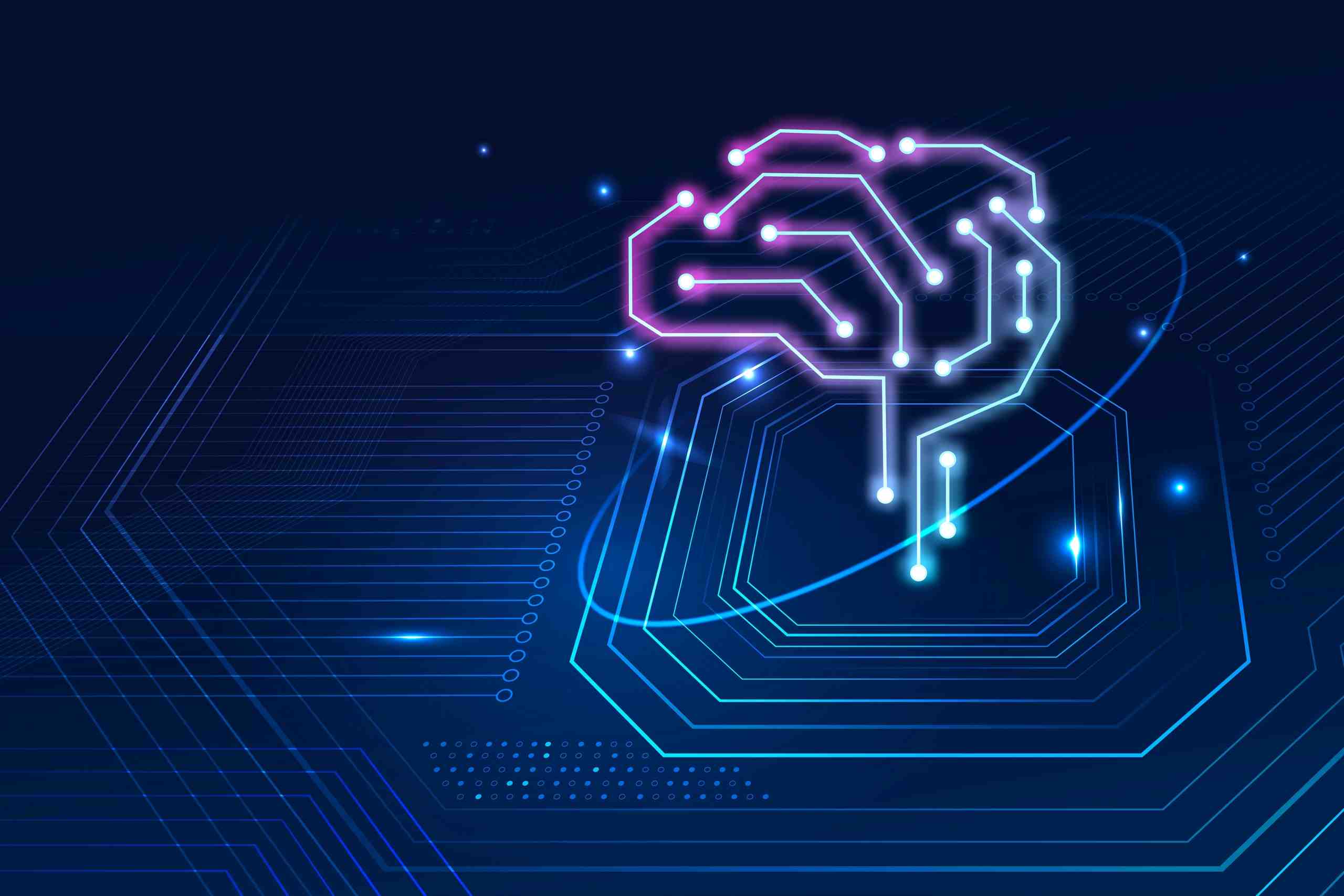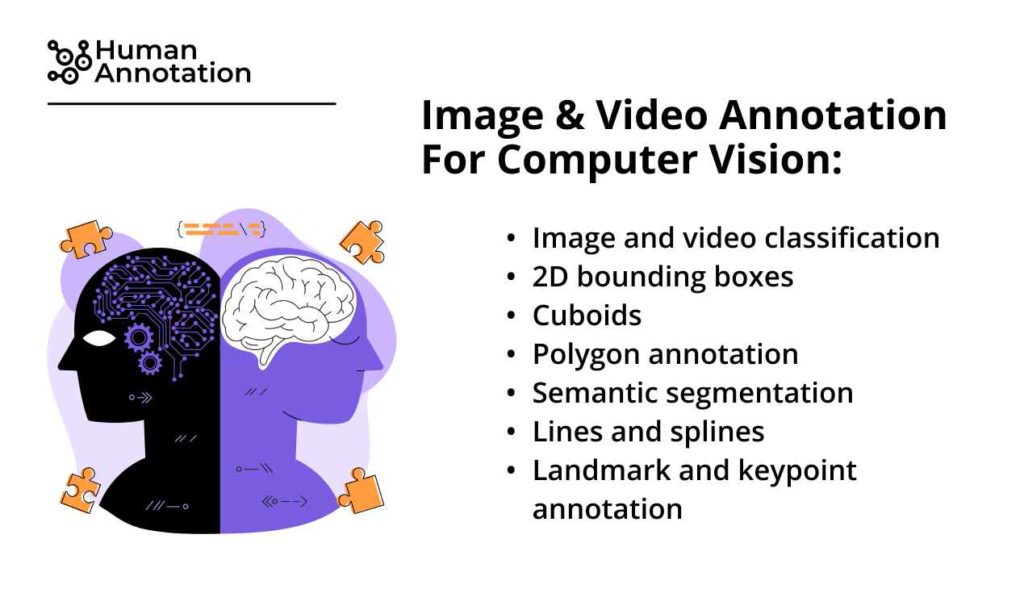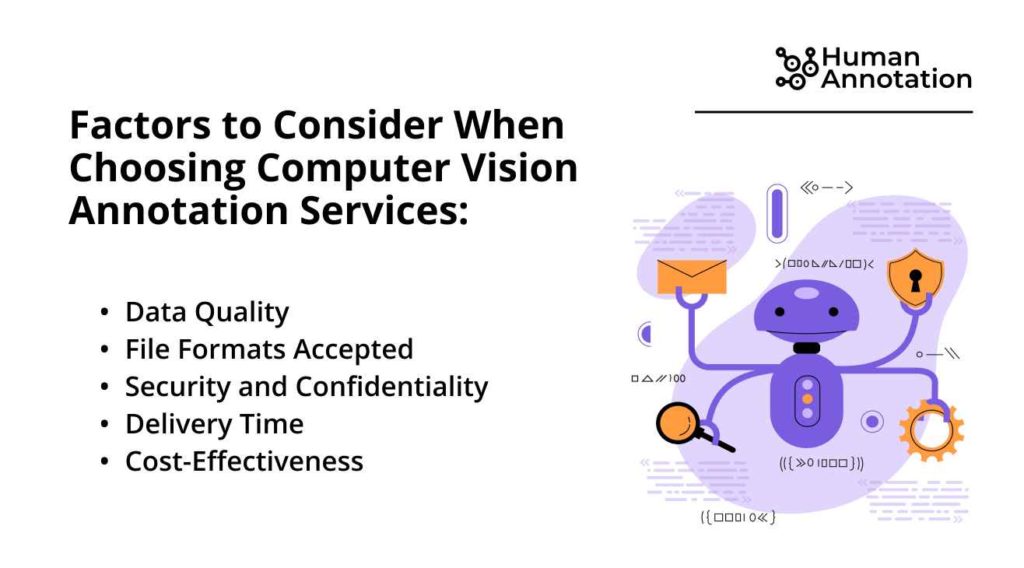
Whichever computer vision (CV) task you want to address, you’ll need a lot of well-annotated training data. And the annotation accuracy will impact the effectiveness of your CV-driven software. But how to build a team where each data annotator is professional and make it cost-effectively? The answer is to choose a reliable outsourcing partner. And in this article, we’ll share how to do it.
What Are Annotation Services and Why Are They Important for Computer Vision?
Annotation services are the scope of tasks on data labeling for computer vision and AI projects performed by experienced annotators. Computer vision tools are named so because they empower machines with human-like vision. CV-driven software empowers security and surveillance cameras, self-driving vehicles, diagnose-detecting tools, plant-growth and car damage analyzing programs, etc.
The accuracy of CV models performing the above tasks depends on the accuracy of their training datasets. In other words, algorithms rely on what human annotators “show” them through labels on images and videos. And professionals place tags correctly, consistently, and without bias. So without exaggeration, the quality of annotation services equals the quality of CV-powered tools.
Different Types of Annotation Services for Computer Vision
Let’s check various types of video and image annotation services. Here’s how data annotators identify objects and elements on visuals:
Image and Video Annotation
The approach to labeling images for computer vision projects is the same as to labeling videos. That’s because each video consists of multiple images, also called frames. However, video annotators don’t have to mark the same objects on each next frame. With AI-assisted tools, they only have to adjust tags made by annotation programs.

- Image and video classification. This approach allows categorizing of entire images and videos with a single label. For instance, short clips can be tagged as “running” or “standing,” while pictures can get the “dog” or “cat” label.
- 2D bounding boxes. These are rectangles that enframe and categorize 2D objects. This technique is used to identify traffic signs, car damages, or elements on X-ray images.
- Cuboids. These are volumetric boxes. One of the challenges of this annotation type is estimating the hidden part of the object. Still, modern annotation tools handle this task.
- Polygon annotation. It allows data labelers to mark the precise boundaries of an object, excluding irrelevant pixels which appear on 2D and 3D boxes. This approach, for example, can be used for marking building footprints.
- Semantic segmentation. When every pixel of an image or video needs to be marked, labelers use semantic segmentation. This annotation type helps self-driving cars understand what is around them.
- Lines and splines. Straight and curved lines are ideal for marking road and floor surfaces in pictures and videos. This helps robotic machines carry inventories in warehouses safely.
- Landmark and keypoint annotation. You can know this approach as dot annotation. Professionals place dots on human faces or across their bodies, which allows them to detect emotions and analyze movements.
Image Transcription
Sometimes valuable text information is stored in the format of images. For example, companies can have terabytes of archived PDF files that need classification. Image-to-text transcription also allows computer vision software to identify house numbers and read road signs with city names.
Extracting texts from images is also known as Optical Character Recognition (OCR), and data labelers use special tools for this task. The texts can then be classified and structured with text annotation techniques.
Looking For Professional Data Annotation Services For Computer Vision Project? Get In Touch With Us!
Factors to Consider When Choosing Computer Vision Annotation Services
With tens of players available in the computer vision labeling market, you’ll need to rate their services against these five parameters:
Data Quality
Does this annotation services provider use labeling tools with quality assurance functions? How does the team ensure consistency of data labeling and avoid bias? Do they regularly discuss disputable cases? What experience will your labelers have? These questions are critical in understanding the quality of this company’s services. And checking a couple of relevant case studies will also help.
File Formats Accepted
Specialists can save annotation tags in three main formats: COCO, YOLO, and Pascal VOC. And though it isn’t an issue to convert labels into other formats, it takes time. So leverage the annotation instrument that allows creating labels in your preferred format. Also, if you work with long videos or large raw datasets, ensure your tool can import, process, and export these files.
Security and Confidentiality
Does your provider store raw and processed files in-cloud or in-house servers? Do they manage access rights depending on the authority, role, location, etc.? Which NDA contracts do they have? Do they compress original files and disperse the labeled ones to prevent data leaks? When will they inform you in case of a data breach?
Delivery Time
Following deadlines is often a challenge, but experienced data labelers should give you a realistic estimate of when they can complete your task. Also, ask them who will keep you updated about the data labeling progress. Discuss what you will do in case they need to extend the deadline, or you’ll decide to increase the volume of files.
Cost-Effectiveness
The main cost of data annotation projects is the price of person-hours. So when comparing different annotation service providers, check if they use AI-assisted labeling tools. They will let you cut the time spent on tagging, leverage more accurate results, and decrease remuneration expenses. Still, don’t engage data annotators with no relevant experience, as they’ll work slower and less efficiently.

How to Outsource Data Annotation for Computer Vision Projects
In addition to the previous criteria, there are a few points you should also consider when choosing your outsourcing partner:
- Explore the tech stack. The proper infrastructure for annotation tasks is critical for the accuracy, speed, and cost-effectiveness of your project. So, summarizing the previous section, ensure your future team will use AI-empowered software for annotation tasks to spend minimum time on the labeling process. Find out how they arrange raw data load and store processed files and which approach to secure data they use.
- Read reviews and case studies. Nobody will tell you more about your potential outsourcing partner than former or existing clients. So check what they say about this company, which features and maybe issues they highlight. Case studies will give you more relevant details about the tools and approaches used, communication formats, and accuracy of the training datasets.
- Check cooperation formats. The more flexible cooperation terms your potential provider offers, the more cost-effective it can be for you. For instance, we let companies start small and hire a part-time labeler for small or new computer vision image annotation projects. If your data volume is a bit larger and requires a full-time specialist, we’ll be happy to help you outsource this person.
Benefits We Offer
Below are the key advantages of hiring your computer vision labeling team with us:
- You’ll build your team promptly. With forward-looking approaches to recruiting, our search specialists can assemble a team for several weeks. They maintain lists of skilled data labelers ready to start working. Also, we leverage leading tools to streamline finding the best-matching candidates. Our professional network allows us to close vacancies quickly. This lets our clients launch projects sooner.
- You’ll hire top experts. Ukraine is one of the leading IT outsourcing destinations. This country boasts skilled programmers, IT product managers, QA specialists, etc. And computer vision data labeling from Ukraine-based experts is also in great demand. Our managers use viral job platforms and leverage searching opportunities on LinkedIn to source top-level labelers. They also create talent pools and use personal networks to find specialists for you.
- You’ll cut costs on your team. Our key benefit is that you can save on payrolls. By hiring annotation practitioners from Ukraine, your monthly voice will be around 20% lower. This economy becomes possible because of the lower overall living index in Ukraine. Moreover, we understand that some companies don’t need large teams as they start ML projects. So we offer outsourcing even one part-time annotation specialist and pay for what you need only.
- You’ll focus on work. When hiring in-house data tagging experts, your HR team will have to deal with tens of tasks to administer your big data project. Our cooperation model takes away most of them, leaving you centered on work. We deal with everything from posting job descriptions, running interviews, and preparing employment contracts. We’ll find the right office and equipment at cost-effective prices and meet all the legal requirements.
- You’ll have shared business hours. One of the issues to consider when hiring people from offshore destinations is the difference in time. Remote annotation teams can tag your images, videos, text, or audio files independently. Still, it’s always better to have an opportunity of arranging a call anytime. Sometimes project owners need to communicate urgent requests and not wait until tomorrow. Luckily, Ukraine has shared business hours with the US and European companies.


